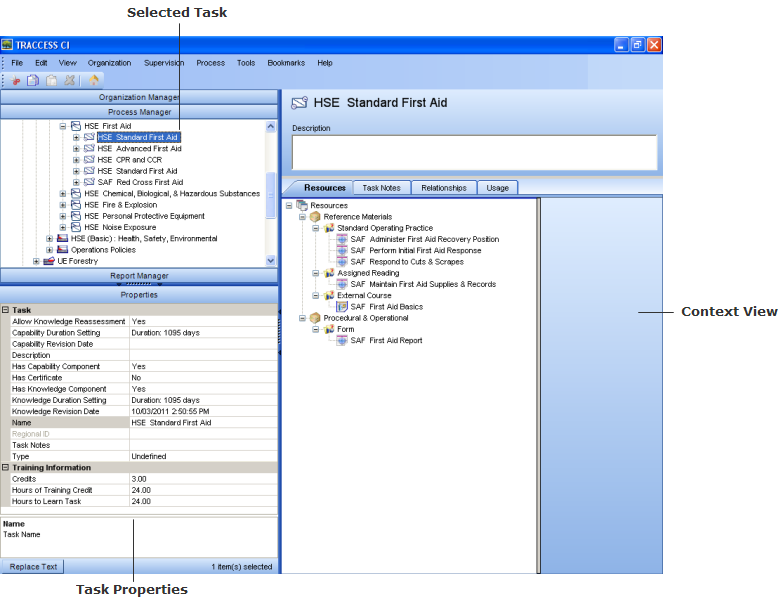
|
|
|
|
When you click on a task, the task properties are displayed on the left, and the Description box, Resources tab, Task Notes tab (if applicable), Relationships tab, and Usage tab are displayed on the right in the context view.

When you right-click on a task in the Process Manager, a menu appears with a number of options.
Cut
Copy
Paste
Remove - takes away the Task assignment to this Sub Process. This same task will remain in its other Process Set/ Process/ Sub Process structures elsewhere in the database. If it does not happen to reside anywhere else, this task will become Unassigned.
Add Capability Assessment - adds a Capability Assessment node beneath the Task name, and opens the internal Capability Assessment context view/ manager. At this point, the Subject Matter Expert can enter Actions/ Action Details to create a Capability Assessment Sign Off form.
Add ASSESS Capability/ Knowledge Assessment - adds an ASSESS Capability Assessment node beneath the Task name. All editing of these types of assessments is completed within the Perception QuestionMark software. At this point, to link an ASSESS Capability Assessment to TRACCESS, you must enter the Identifier Number for the Assessment, as well as the ASSESS URL (or the location of the ASSESS database).
The differences between the creation of an ASSESS Knowledge and Capability assessment is that
Capability questions are written for the supervisor to answer on behalf of the learner. Knowledge Assessment questions are written for the Learner to answer.
TRACCESS allows two different tests to be added for the Knowledge Component (Practice and Final Assessments). The Capability only has a single assessment to attach.
The results of the Capability Assessment can be viewed by way of a Coaching report. There is no parallel to the Coaching report in the Knowledge component.
Add SCORM Knowledge Assessment/ Resource - a SCORM Module can be added in two ways to a Task, as the knowledge assessment component itself, or as a Resource that may/ may not satisfy the testing component.
If the SCORM is linked as a Knowledge Assessment, learners would access their SCORM module in the same way that they would access their other Knowledge Assessments - by clicking on the ![]() button.
button.
If the SCORM is linked as a Resource, learners would access their SCORM module by clicking on the ![]() button.
button.
Add/ Remove Owners - Since more than one Subject Matter Expert can be assigned to the same Process, an Owner(s) can be assigned to a particular Task. If an Owner is assigned to a particular Process, only that person can change the properties of the Task.
Click the ![]() button choose from a list of employees to assign as a Task Owner.
button choose from a list of employees to assign as a Task Owner.
There are two exceptions to this rule:
1. In the Role Permissions for a Subject Matter Expert (Tools/ Role Permission Sets), there is an option of Edit All Tasks (Owner Override). If this function is enabled, all SMEs that have access to the Task will be able to modify it.
2. A System Owner has rights to everything in the system, regardless of this setting.
Add/ Remove Prerequisites - as with many "things to do", completion of a task may depend on acquiring knowledge of another task. If this is the case, a Prerequisite Task(s) can be assigned to each Task.
Click the ![]() button choose from a list of Tasks to assign as a Task Prerequisite.
button choose from a list of Tasks to assign as a Task Prerequisite.
Name - in TRACCESS, all Task names must be unique.
Description
Allow Knowledge Reassessment - if the knowledge component of a task does not contain a duration, completing the knowledge assessment once should have it remain complete (unless the material becomes revised). However, if the knowledge component of a task contains a duration, the concept of the duration itself is having to re-qualify on a task from time to time. If the "Allow Knowledge Reassessment" is set to No, this will disallow learners from retaking a final Knowledge Assessment if the knowledge component is already in its Complete state. In this case, "Complete" includes both the Complete (Black Component with Black Clock), and About to Elapse (Black Component with Red Clock) states.
Since the previous versions of TRACCESS CI did allow for knowledge reassessment, the default state for tasks is set to Yes. However, if you wish to make use of this functionality - disallowing learners from "accidentally" resetting their Knowledge components to incomplete, you may wish to set the default to No for all future Tasks. This is done using the Object Definitions dialog, selecting the Task object, and changing the default value in the Defaults tab.
Please note: If a Task does have this setting as No, a Learner will not be able to requalify on tasks that are About to Elapse until they actually Elapse. Therefore, if you have an Event set up that warns people XX number of days prior to a duration lapse, they may not be able to rectify the situation until the task actually goes white. In this case, you may choose to set your Event timing with a warning that is sufficiently small or at 0 days, or not set the Allow Knowledge Reassessment to No.
Knowledge/ Capability Revision Date - when something within a task changes, several things need to happen. The resource must be revised. The knowledge and capability assessments must be updated to test on the revisions, and the date the changes come into effect must be set in these fields. For those employees who had previously completed the task, they will be notified of this change in potentially three ways: they will receive an email message, their revised task will appear in their Critical Tasks section of TRACCESS Today (under the Revised Tasks), and a part of their Qualification Summary section (their Pie) may turn red. For those who had never completed the task before, they will simply be presented the new information when they study the task.
Has Knowledge/ Capability Component - By default, when you first add a Task to the system, it will be white. However, you may wish to change these settings to Has Knowledge/ Capability Component to No, and this way the Task will be grey (or under construction). This way, you will know that you still have to add the assessment components as long as the Task is grey.
Has SCORM Resource
Task Notes - This is an RTF field that can be used as a bulletin board of all of the changes that have happened to a Task. For example:
Mar 21, 2006 Task Created
Mar 25, 2006 Resources Added
June 1, 2006 Knowledge Assessment Added
Jan 30, 2007 Resources Revised/ Knowledge Assessment Questions Modified/ Knowledge Revision Date Set
If the Task does not contain any notes, the Notes tab will not appear in the Context View.
Please Note: Task Notes apply to the Task in general and are not specific to individual Employees.
Knowledge/ Capability Duration Setting - By default, when you first add a Task to the system, it will be white. However, you may wish to change these settings to Has Knowledge/ Capability Component to No, and this way the Task will be grey (or under construction). This way, you will know that you still have to add the assessment components as long as the Task is grey.
Credits - As with High School or Post Secondary Courses, you may attribute a credit value to each of the Tasks in the system. A person is attributed that number of credits based on a completion status.
Hours of Training Credit - some tasks may be measured in Credits, but others may be measured in hours. Certain tasks require a certain number of hours to be completed in particular disciplines in order to gain certification.
Hours to Learn Task - if a Learner was allotted a certain number of hours for training, this particular field may be useful to know. In most cases, when a task is equivalent to taking a course, the time it takes to learn the task and the duration of the course are the same. However, there may be some cases where you are required some practice time over and above the course hours. This field could be used to capture this information.
When a task is selected from the Process Manager tree, the context view displays the task name, Description box, Resources tab, Task Notes tab (if applicable), and Relationships tab. Note: The Task Notes tab will only appear if the task has notes.
Every object in the database, such as a task, contains a description field that can be used to make the task name more descriptive, but it can also be left blank. The description is edited from the Properties when a task is selected.
![]()
The Relationships tab identifies all resources that are attached to the selected task. A task can contain as many resources as required to complete the task, and resources can exist in any file type. Right-clicking on the Resources heading, which appears below the task name in the Process Manager tree, allows you to select from an existing list of Resources or create Course, Document, Help File, or URL resources.
Resources can also be assigned categories and subcategories, which are used to sort the resources. If a resource is not assigned to either a category or subcategory, it is displayed in a flat list.
Categories and subcategories are added to the system by accessing their corresponding dialogs (Resource Categories/Resource Subcategories) through the Tools/ System Options/ Task Tab.
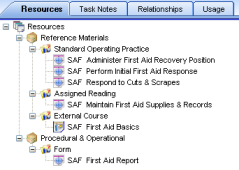
A Task Notes tab will appear only if notes have been added to a selected task. Task Notes are edited in the Properties section when a task is selected.
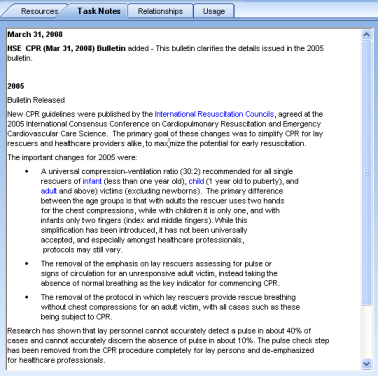
Prerequisites - Displays the prerequisite task(s) required to complete the selected task. Click Add/Remove to add and remove prerequisites from a task.
Owners - Displays the owner(s) of the task. The name of the SME who created the task will appear. If a System Owner created the task, a name will not appear. Click Add/Remove to add and remove owners.
Tasks to Auto-Complete - Displays the tasks that will be automatically completed once the selected task is complete. The task may provide auto-complete for Knowledge, Capability, or both by clicking on the Provides Knowledge/Provides Capability checkboxes. Click Add/Remove to add and remove Auto-Completion tasks.
Auto-Completed By - Displays the tasks that would auto-complete the currently selected task (if applicable).
Tasks to Auto-Complete (lower left-hand box) - If the selected Task is part of a group of Tasks that auto-completes a Task, this box displays the Task that the group of Tasks auto-completes.
Provides Knowledge - Clicking this checkbox will auto-complete the Knowledge component of the task shown in the Tasks to Auto-Complete box. (Only shown if the Task contains this component.)
Provides Capability - Clicking on this checkbox will auto-complete the Capability component of the task shown in the Tasks to Auto-Complete box. (Only shown if the Task contains this component.)
Auto-Completed when all of these are completed - When all the Tasks in this box are completed, they will auto-complete the selected Task. Click Add/Remove to add and remove grouped Tasks.
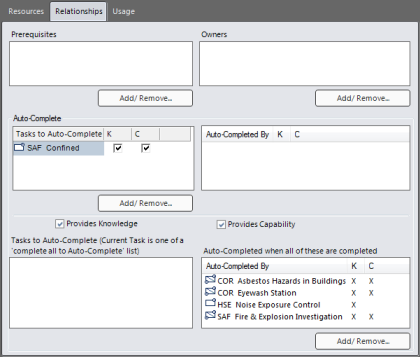
The Usage tab provides SMEs with a fast and easy way to identify all the places a task is being used or reused in the system—more specifically, where tasks exist in Processes and Direct Assignments. This function is especially useful when a change needs to be made to a task. It gives an SME a complete understanding of how the change could affect the system.
The Usage tab is split into two windows:
Process Manager - Displays, in a hierarchial tree, where the task exists in Process Sets, Processes, and Sub-Processes within the system.
Direct Assignments - Displays the names of the employees the task is assigned to as a Direct Assignment.
Tasks are removed from the Process Manager and Direct Assignments with the remove button:
Remove - Under the Process Manager window and the Direct Assignments window is a Remove button. A task can be removed from anywhere it exists by clicking on the task, then clicking Remove. Or, a task can be removed from a Direct Assignment by clicking on the person's name, then clicking Remove. The deletion can be undone by selecting Edit > Undo from the main menu. If the task appears more than once in a Direct Assignment Process, it will only be listed once; however, selecting Remove will remove all instances of the task from that Process.
Direct Assignments can be multi-selected by holding down the Ctrl key and then clicking on the direct assignments you want to remove the task from. You can then click on the Remove button, and the task will be removed from all selected Directed Assignments.
Tasks can also be double-clicked:
Double-clicking on a task in the tree attempts to jump to the task in the left-panel Process Manager tree.
Double clicking on a name in the Direct Assignments list attempts to jump to the Direct Assignments process in the corresponding person's Assigned Learning tab.
The double-click jumps fail if the user does not have access to the jump-target destination.
Note: The user must have permissions to remove selected tasks.
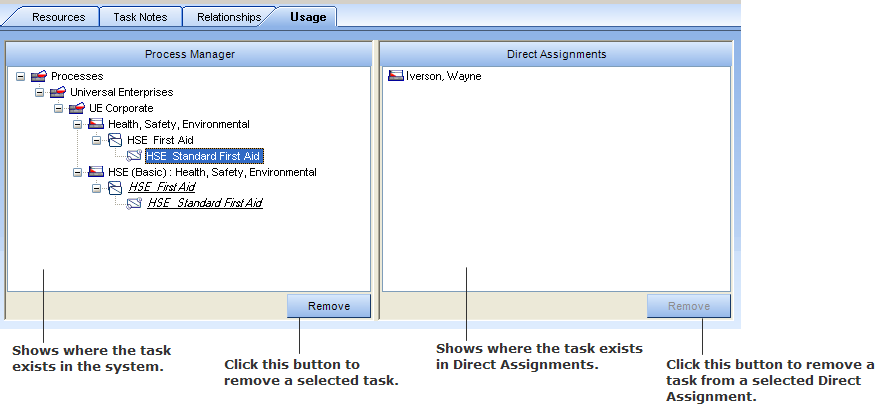
Additional Help:
About/Using Tasks to Auto-Complete
Add/Remove Auto-Complete Tasks
About/Using Multiple Tasks Auto-Complete a Task
Add/Remove Multiple Tasks Auto-Complete a Task